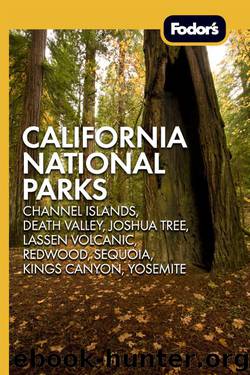California by Fodor's

Author:Fodor's
Language: eng
Format: mobi, epub
ISBN: 9781400005611
Publisher: Fodor's Travel Publications
Published: 2010-08-23T20:00:00+00:00
* * *
Previous Chapter | Beginning of Chapter | Next Chapter | Contents
SEQUOIA SPORTS AND THE OUTDOORS
Previous Chapter | Next Chapter | Contents
The best way to see Sequoia is to take a hike. Unless you do so, you’ll miss out on the up-close grandeur of mist wafting between deeply scored, red-orange tree trunks bigger than you've ever seen. If it's winter, put on some snowshoes or cross-country skis and plunge into the outscale woodland swaddled in snow. There are not too many other outdoor options: no off-road driving is allowed in the parks, and no special provisions have been made for bicycles. Boating, rafting, and snowmobiling are also prohibited.
BICYCLING
Steep, winding roads and shoulders that are either narrow or nonexistent make bicycling here more of a danger than a pleasure. Outside of campgrounds, you are not allowed to pedal on unpaved roads.
BIRD-WATCHING
More than 200 species of birds inhabit Sequoia and Kings Canyon national parks. Not seen in most parts of the United States, the white-headed woodpecker and the pileated woodpecker are common in most mid-elevation areas here. There are also many hawks and owls, including the renowned spotted owl. Species are diverse in both parks due to the changes in elevation, and range from warblers, kingbirds, thrushes, and sparrows in the foothills to goshawk, blue grouse, red-breasted nuthatch, and brown creeper at the highest elevations. Ranger-led bird-watching tours are held on a sporadic basis. Call the park's main information number to find out more about these tours.
Contact the Sequoia Natural History Association (HCR 89, P.O. Box 10, Three Rivers, CA 93271 | 559/565–3759 | www.sequoiahistory.org) for information on bird-watching in the southern Sierra.
CROSS-COUNTRY SKIING
For a one-of-a-kind experience, cut through the groves of mammoth sequoias in Giant Forest. Some of the Crescent Meadow trails are suitable for skiing as well. None of the trails is groomed. You can park at Giant Forest. Note that roads can be precarious in bad weather. Some advanced trails begin at Wolverton.
Pear Lake Ski Hut.
Primitive lodging is available at this backcountry hut, reached by a steep and extremely difficult 7-mi trail from Wolverton. Only expert skiers should attempt this trek. Space is limited; make reservations well in advance. | Trailhead at end of Wolverton Rd., 1½ mi northeast off Generals Hwy. (Rte. 198) 93262 | 559/565–3759 | $38 | Mid-Dec.–mid-Apr.
Wuksachi Lodge.
Rent skis here. Depending on snowfall amounts, instruction may also be available. Reservations are recommended. Marked trails cut through Giant Forest, just 5 mi south of the lodge. | Off Generals Hwy. (Rte. 198), 2 mi north of Lodgepole 93262 | 559/565–4070 | $15–$20 ski rental | Nov.–May (unless no snow), daily 9–4.
FISHING
There's limited trout fishing, bagging minimal hauls, in the creeks and rivers from late April to mid-November. The Kaweah River is a popular spot; check at visitor centers for open and closed waters. Some of the park's secluded backcountry lakes have good fishing. A California fishing license is $11.30 for one day, $17.60 for two days, $34.90 for 10 days (discounts are available for state residents) and is required for persons 16 and older.
Download
This site does not store any files on its server. We only index and link to content provided by other sites. Please contact the content providers to delete copyright contents if any and email us, we'll remove relevant links or contents immediately.
Giovanni's Room by James Baldwin(6820)
The Plant Paradox by Dr. Steven R. Gundry M.D(2434)
The Stranger in the Woods by Michael Finkel(2330)
Miami by Joan Didion(2166)
Wild: From Lost to Found on the Pacific Crest Trail by Cheryl Strayed(2144)
INTO THE WILD by Jon Krakauer(2087)
Trail Magic by Trevelyan Quest Edwards & Hazel Edwards(2064)
DK Eyewitness Top 10 Travel Guides Orlando by DK(2058)
Vacationland by John Hodgman(2034)
The Twilight Saga Collection by Stephenie Meyer(2029)
Nomadland by Jessica Bruder(1960)
Birds of the Pacific Northwest by Shewey John; Blount Tim;(1876)
The Last Flight by Julie Clark(1837)
Portland: Including the Coast, Mounts Hood and St. Helens, and the Santiam River by Paul Gerald(1821)
On Trails by Robert Moor(1794)
Deep South by Paul Theroux(1718)
Blue Highways by William Least Heat-Moon(1664)
Trees and Shrubs of the Pacific Northwest by Mark Turner(1645)
1,000 Places to See in the United States and Canada Before You Die (1,000 Places to See in the United States & Canada Before You) by Patricia Schultz(1558)
